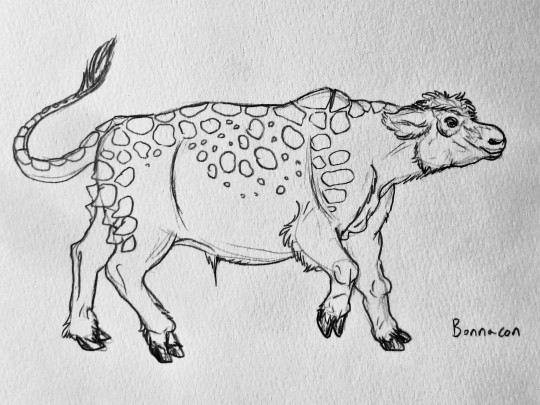#the fire-farting legendary cow
Text

Ancardia's Unusual Animals--The Bonnacon
Classification: Beast (bovine)
Habitat: Grass and scrublands in the Western regions, especially the Ayn Coastlands, Silver Coastlands, and parts of the Fallar and Western Heartland.
Bonnacon are perhaps among the most bizarre wild bovines to exist in Ancardia, and this is chiefly because of their main form of self-defense. While most hooved beasts have great speed and awareness, or great size and impressive horns, bonnacon have none of these but one very strange natural weapon. With the back, hips, shoulders and tail covered in squat, tough keratin scales, bonnacon average as slightly smaller than a domesticated auroch and slightly larger than a gnu, and lack horns altogether. Their only defense is their natural arcane abilities—which are limited to igniting gases from their rears into a sheet of flame that can reach pursuers as far away as 12 meters. This flame is unusually hot, and tends to not only ignite hair, clothes and wooden weapons, but is also hot enough to heat steel and other highly-conductive metals to a burning temperature within 15 seconds, as well as warp and distort glass. A wild creature, the bonnacon is also dangerously skittish, and will bolt and flame at the slightest provocation. The only known natural predators of the bonnacon are the Crocotta and the Antediluvian Dire-Drake, both of which use ambush tactics and superior jaw strength to quickly attack the beast from the front, before it can turn around and become a real danger.
Bonnacon are unlike many wild ungulates in that they don’t live in large herds, most likely due to the issue of friendly-fire if a large group of bonnacon were spooked all at once in close proximity to each other. Bonnacon herds usually number only between 5 and 12 individuals, led by one breeding male along with a few adult females, sometimes also with their adolescent and juvenile young. Bonnacon browse a large variety of tougher vegetation, being very well adapted to semi-arid and dry montane climates, and are especially resilient in areas with a large density of toxic plant species, such as hogweed, daturas, prickly nightshades and euphorbias. It is believed that something to do with the toxicity of the plants it prefers gives it greater ability to shoot fire. Bonnacon are born able to stand and then run within about ten minutes, and area also born able to shoot flame as well, though not as strongly. It takes roughly 2 years for a young bonnacon to grow to close to adult size, though it is only in the third year that it is fully developed.
In older Ages, the Old Kingdoms Empire’s nobility often considered hunting bonnacon to be a mark of high status—no doubt due to the sheer suicidal nature of any activity that involves approaching such a beast, especially of chasing one. Dogs and servants on horseback were usually sent ahead of their leigelords with the rationale being to bait the bonnacon into expending all of its ammunition before the lords on horseback themselves were meant to overtake the animal and attack it with spears or shortbows; several ancient nobles famously were torched to death as the creatures’ defended themselves anyways, and one notable taxidermized bonnacon specimen from the 4th Age is nowadays believed to be a hoaxed example made out of attaching pieces of tortoise shells to a dead calf. Among other cultures, bonnacon are sometimes considered pests. Sahel hurthling tribes who keep dairy auroch, zebu, and other bovines are often tasked with creating scarecrow-like puppets they can raise up and deploy from afar in order to scare off roaming wild bonnacon—as bonnacon can interbreed with some other bovines and result in a heifer calf that will grow to produce a foul, sulphureous milk. Others, like the Frost Giants and Sostunian tribes, are known to create spiked stone walls outside of their normal spiked wooden fencing separated by a few meters, strictly to keep bonnacon from getting too close to wooden structures and crop fields and ending up incinerating them and the fences if they are scared away by guard animals or farmers.
#ancardia#ancardian homebrew#bestiary#mixed media#creatures#animals#Ancient Domains of Mystery#ADOM#Dnd-like#Bonnacon#the fire-farting legendary cow#yes really
2 notes
·
View notes